Abstract
Nowadays the tramway is a means of transport that is frequently used in Constantine city, the tramway of Constantine took its place in the landscape and improved the offer of public transportation in Constantine city with its capacity to transporting 6000 travelers per hour. This means of transport is experiencing a gain of interest for its qualities: ability, comfort, speed, and improving accessibility to the city center. Despite these advantages there are some problems related to users’ comfort like the noise and vibration caused during the operation, track rail, engine blocks and other traction equipment are among the main sources of vibration. On this paper, we present the type of tram used and the level of vibration caused by the traction elements and by rail track inside the tramway Alstom Citadis 402. We also made a survey based on the opinion of users of the Constantine’s tramway about the discomfort level caused by the vibration and how it effects on the comfort of passengers, this is in order to improve furthermore the comfort in the conception of tram extensions to other urban areas in the city.
1. Introduction
Between 2011 and 2016 the number of kilometers of urban railways built in Algeria almost tripled, three Algerian cities have a tramway network with 105 trams and ongoing construction of a tram network for five other cities [1].
The tramway is becoming a means of transport helping in part to decongest vehicular traffic in cities and thus reduce emissions of CO2, noise and vibration generated can be a source of nuisance to neighboring homes and for those who use it [2].
The use of trams as a public urban transport vehicle is restricted by the noise and vibration, to lower these two factors inside and outside the vehicle, huge efforts are made by the tram manufactures [3], a several vibrations might be felt in the range of 5-80 Hz [4].
Nowadays, in order to improve the situation of living in the neighborhood of railways, we must reduce the nuisance of vibration because users of the tramway are bothered by the high level of noise and vibrations [5], the comfort of the driver and passengers is strongly affected by the exposure to this vibration [6].
2. Architecture of the tram and characteristic
The proposed vehicle as part of this offer is from the CITADIS range, under reference CITADIS 402, its type is 100 % low-floor, 75 % motorized vehicle and total capacity 302 passengers.
The vehicle is bidirectional and it is expected to operate as a single unit. The tram is composed of seven articulated section, the base vehicle CITADIS 402 includes the following modules:
• 2 motorized cabin (M1 et M2);
• 1 carrier nacelle(NP);
• 1 motorized nacelle (NM);
• 3 suspended central section (cars-bodies) (C1, C2 et CC) [7-10].
The vehicle section is curved to the radius of 10 meters, the external width is 2650 mm to optimize the constraints of maintain and comfort in the right seats and interior width of 2,490 m. The length of the vehicle is 43.763 meters; this value is likely to change very slightly with the finalization of the cabin aesthetics. The proposed width, combined with the length of the vehicle, enables an important capacity and offer comfort to passengers.
Fig. 1Architecture of tramway Constantine

The Constantine’s tramway contains 4 bogies:
• 2 motorized bogies extreme type Alstom ARPEGE 350 M,
• 1 motorized bogie type Alstom ARPEGE 350 M,
• 1 bogie type of carrier Alstom ARPEGE 350 P.
The motor is three-phase asynchronous squirrel cage, sealed and cooled by heat transfer fluid, the mass of the traction motor is about 350 kg, its maximum power is 180 kilowatts and power in continuous operation is 120 kw [7-10].
Fig. 2Motorized bogie Citadis 402
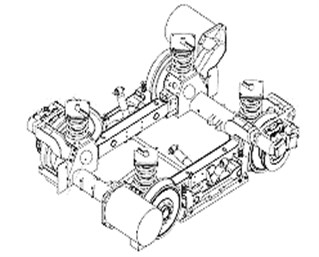
3. Track conception criteria
In urban areas, the rails used in Constantine are mainly grooved rails, in order to be drowned in the roadway. The excitement wheel rail is among the major sources of vibration inside the tram. The track design is based on the following constraints:
• Users comfort;
• Security of passenger;
• Level of noise;
• Level of vibration
• Maximum speed along the track layout;
• Simple construction;
• Simple maintenance.
The type of track laying will be according to the environment:
• Classic (common);
• Anti-vibration;
• The track gauge is 1435 mm;
• On floating slab;
• On classic work of art;
• Direct installation on concrete in the buildings of the deposit;
• Laying on stilts for pit-tracks in the workshop [11].
Fig. 3Rail of Constantine tramway
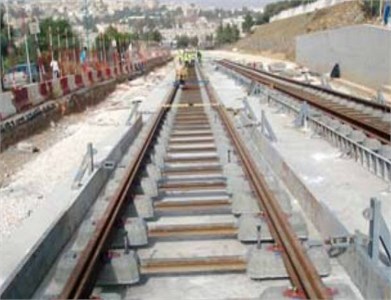
Fig. 4Track gauge
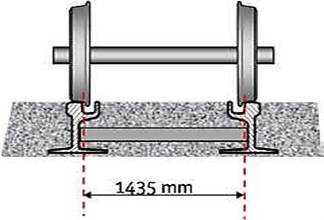
4. Traction system
The traction system of tram includes:
• The socket by pantograph bow fitted with carbon bands;
• The protector;
• The main circuit breaker (DJ) that puts all the equipment under voltage but opens automatically in case of short circuit to protect the rest of the components;
• The static converter (CVS) which can produce from 750 V;
• The contact line, three-phase alternating voltages or continuous, variable amplitude;
• The traction motors;
• The return brushes of the line current and setting the potential of rail vehicles, each of these functions being provided by separate devices housed in the wheels [12].
Fig. 5System of traction energy of Constantine tramway
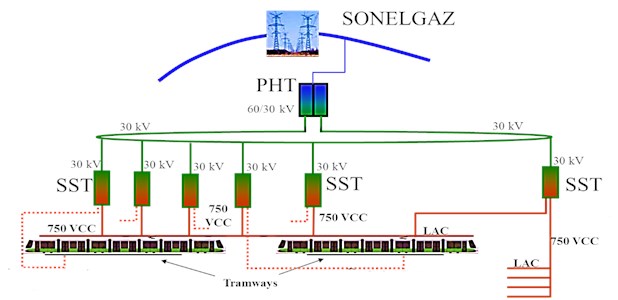
5. Mapping of the level of vibration inside the Constantine’s tramway
The mapping of the vibration is a result of investigation and measures to recognize the vibration that propagate inside of the tram on the line of Constantine’s tramway and this in order to increase the level of comfort and put passengers in good travel conditions. The vibration level inside the tram is not constant, it increases and decreases relatively to the different sections on the line of tramway, we notice that the level of vibration attain high levels on some sections. The contact wheel rail, the organs of traction, associated transmission and tramway operation (speed, brake...) are the main causes of this high vibration which causes a huge discomfort to passengers whom expect a better enhance travel conditions for existent line and new extensions.
Fig. 6The level of vibration inside the Constantine’s tramway
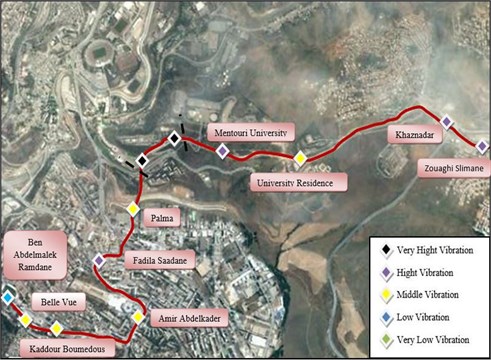
6. Results of the survey
Constantine city is the capital of eastern Algeria, the population has been defined as external customers, users of the tram. A random sample of 250 passengers was selected inside of the tram and in tram stations, the survey was conducted in August 2016 and the progress of the survey took place at different times of the day. A survey contains personal questions and questions about vibration in order to know if vibrations affect their comfort or not.
The users of the tram are of both genders, the rate of male and female is near, 56 % for female and 44 % for men, and this is evidence of democratization of this means of modern transportation by the whole population.
Fig. 7 represents the response of the tram users who are of both genders, male and female, we observe on the histogram that 39.60 % of tram passengers are bothered by the vibrations caused by the tram and this dissatisfaction rate is very high.
Fig. 7Overall sample analysis
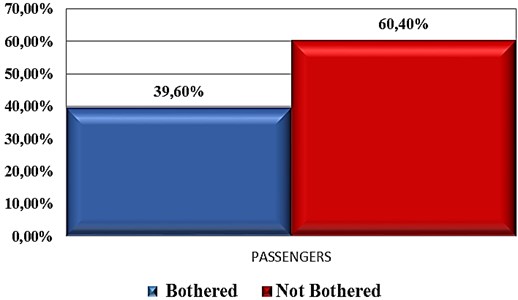
In Fig. 8 we note that 35 % of women who use this means of modern transportation are not satisfied from the disturbance caused by the vibration inside the tram and that almost half of men 45.45 % that responded to the questionnaire are very embarrassed over this vibration felt inside the tram.
Fig. 8Sample analysis of passengers by gender
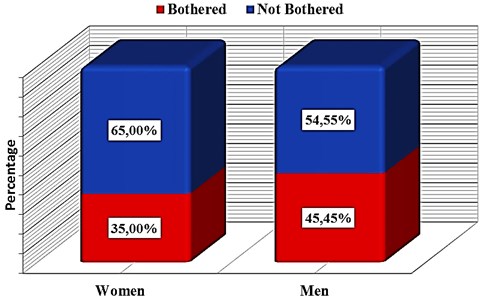
Fig. 9 shows the sample according to the age of the passengers, the main categories of tram users are those who have between 18-25 (years) corresponding to the categories of young people and between 26-49 (years) corresponding to the category of workers, we note that these two categories of passengers are more bothered by internal vibration of the tramway than the older category because the tram is the mode of main transport for these two categories of passengers.
Fig. 9Sample analysis of passengers by age
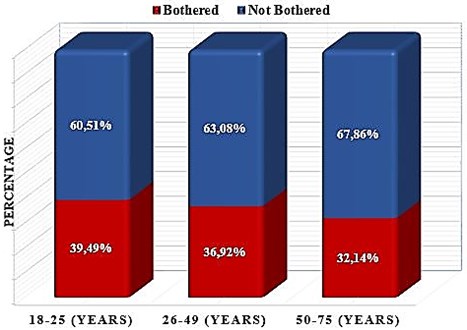
7. Conclusions
This paper is a contribution to what has been done before as work on noise and vibration of the tram, but unlike the other work it was based on the vibration inside the tram in order to know and limit the level of discomfort caused by these vibrations to increase comfort.
In this work we presented the rolling stock used, the route of the tramway of Constantine and the traction system because we see that these are the main causes of vibration felt by the passengers inside the tram and that's also what we noticed from measurements made inside the tram especially on some sections of the line. The not respected speed on some sections, the bad maintenance of track and traction equipment are the sources of the problem.
The investigation that was done with users of the tram proves that this vibration is really important and embarrassing and it negatively affects their comfort, third of passengers are bothered of these vibrations, we noticed that users who take this means of transport regularly are more bothered than the others. Men are more discontent than women and old people are less bothered than young from these vibrations.
Finally, the tramway of Constantine remains a pride for the people of Constantine who finds a safe and reliable way to transport except that comfort due to vibration and noise in the design of the new extension in Constantine city has to be improved.
References
-
Segaudi Lionel, Ecotiere David, Dutilleux Guillaume, Puymérail Jean-Francois Directivité locale pour trois tramway français. 10th Congres Francais d'Acoustique. Lyon, 2010, (in French).
-
Bleu Crayon Filière de Valorisation des Pneus Usagés Aliapur. Rapport Aliapur d‘Activité, France, 2009, p. 35, (in French).
-
Uhl T., Wszolek W., Wszolek T., Karpinski J. Noise and vibration problems in tram design. Proceedings of Internoise, The International Congress on Noise Control Engineering, Florida, USA, Vol. 1, 1999, p. 283-288.
-
Maldonado Marc Vibrations dues au passage d’un tramway modélisations numériques et validations expérimentales. 15th Colloque National de la Recherche en IUT CNRIUT, Lille, 2009, (in French).
-
Lakušić Stjepan, Ahac Maja Rail traffic noise and vibration mitigation measures in urban areas. Technical Gazette, Vol. 19, Issue 2, 2012, p. 427-435.
-
Burdzik Rafał, Kuminek Tomasz, Mańka Adam, Młyńczak Jakub, Mikulski Jerzy Research on vibroacoustic phenomena of tram vehicles for the changeable dynamics conditions. Vibroengineering Procedia, Vol. 3, 2014, p. 408-412.
-
Spécifications Fonctionnelles et Techniques Générales du Materiel Roulant. Entreprise Metro d’Alger (EMA), 2010, p. 12-14, (in French).
-
http://www.public-library.net/articles/Alstom_Citadis.
-
http://www.cital-dz.com/produits-services/citadis.
-
http://www.ferro-lyon.net/nouveau-tram/498-Les-Rames-Citadis-402.
-
Présentation Générale du Système de Transport. Entreprise Metro d’Alger (EMA), 2008, p. 24, (in French).
-
Muller Georges Traction ferroviaire: les tramways systèmes, exploitation et conception. Techniques de l’Lingénieur Infrastructure Ferroviaire et Matériel Roulant. Vol. 2, 2007, p. D5551, (in French).
